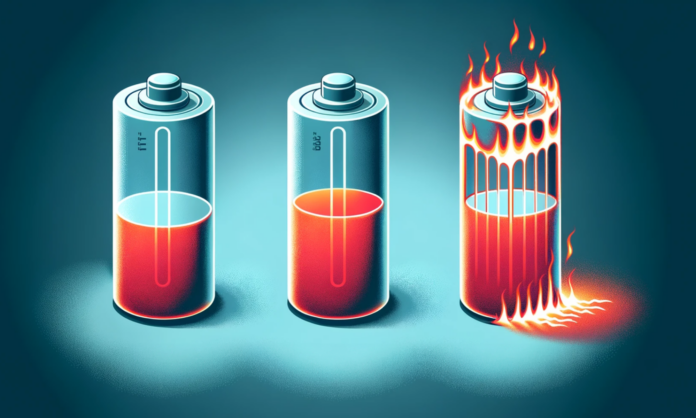Table of Contents
Introduction to Thermal Runaway
Thermal runaway in lithium-ion batteries is a critical safety concern, often overlooked until it’s too late. This phenomenon occurs when a battery becomes self-destructive due to uncontrolled thermal conditions, leading to potential hazards. Understanding thermal runaway is crucial, not just for battery manufacturers but also for end-users, ensuring safety in various applications, from smartphones to electric vehicles.
Defining Thermal Runaway
At its core, thermal runaway is a chain reaction within a battery that leads to rapid temperature and pressure increase. This reaction starts when the battery’s internal temperature reaches a point that causes a breakdown of the internal components. It can escalate quickly, potentially leading to a fire or explosion. Defining thermal runaway involves understanding its stages, from the initial trigger to the final catastrophic event.
Causes of Thermal Runaway in Lithium-Ion Batteries
The causes of thermal runaway in lithium-ion batteries are diverse and often interrelated. Here’s a more in-depth look:
- Internal Short Circuits: The most common cause, these occur due to physical damage, manufacturing defects, or the breakdown of internal separators. This leads to direct contact between the anode and cathode, causing a rapid increase in temperature.
- Overcharging and Discharging: Exceeding the recommended charging limits or discharging rates stresses the battery. This not only degrades the battery but also increases the likelihood of overheating and thermal runaway.
- External Heat Sources: Batteries exposed to high ambient temperatures or near heat-generating devices can reach critical temperatures more easily, triggering thermal runaway.
- Electrolyte Breakdown: At high temperatures, the electrolyte in lithium-ion batteries can break down, leading to the generation of gases and further heat, exacerbating the situation.
- Poor Battery Management Systems: Inadequate BMS (Battery Management Systems) can fail to regulate charging and discharging properly, leading to uncontrolled temperature increases.
- Age and Wear: Over time, batteries degrade. Older or heavily used batteries are more prone to developing internal issues that can lead to thermal runaway.
Understanding these causes is key to implementing effective prevention strategies, ensuring the safe operation of lithium-ion batteries across various applications.
Lithium-Ion Battery Thermal Runaway Temperature
Identifying the trigger temperature for thermal runaway is complex, as it varies based on battery composition and design. Generally, lithium-ion batteries become vulnerable to thermal runaway at temperatures above 80°C (176°F). Once this threshold is crossed, the risk of chemical reactions leading to thermal runaway increases significantly. Understanding this temperature limit is crucial for safe battery design and usage.
Impact of Thermal Runaway
The impact of thermal runaway in lithium-ion batteries extends beyond the immediate risk of fire or explosion. It compromises battery integrity, leading to irreversible damage and potential loss of functionality. In larger systems, like electric vehicles or energy storage solutions, thermal runaway can have catastrophic consequences, posing serious safety hazards to users and the environment. The economic implications are significant too, with the potential for costly recalls and damage to brand reputation.
Preventing Thermal Runaway
Preventing thermal runaway in lithium-ion batteries involves a multipronged approach:
- Robust Design and Manufacturing: Implementing stringent quality control measures to prevent internal short circuits.
- Effective Battery Management Systems: Ensuring advanced BMS that accurately monitor and control charging and discharging processes.
- Temperature Regulation: Implementing cooling systems and thermal barriers to manage battery temperature effectively.
- Education and Awareness: Educating users about proper handling, charging, and storage of batteries.
- Regular Inspections and Maintenance: Periodically check battery health, especially in high-demand applications, to identify potential risks early.
Conclusion
Understanding and mitigating thermal runaway is vital for the safe utilization of lithium-ion batteries. Through continuous research, technological advancements, and adherence to safety standards, the risks associated with thermal runaway can be significantly reduced, paving the way for safer and more reliable battery technology.
